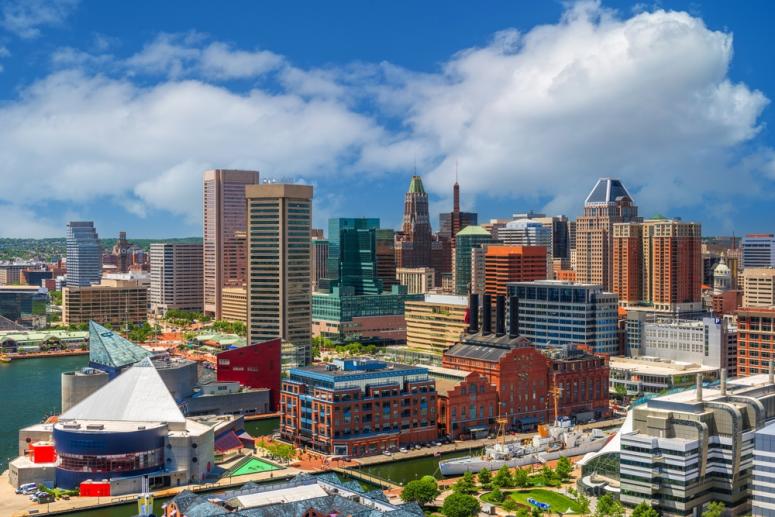
Baltimore is a great American city, but like other great American cities, it faces challenges. Growing up here, I saw these challenges first-hand, yet also saw the creativity and resiliency of communities. Maybe that’s why I’ve focused my work on the health care safety net, particularly community health centers and other organizations that view health care as a right, regardless of a patient’s ability to pay. Now, as I return to Baltimore as a safety net-focused researcher and policy analyst, I’ve been reflecting on my hometown, the challenges and improvements it has seen, and how communities are using innovative research-proven interventions to continue to make strides.
Baltimore’s neighborhoods have long struggled with intentional disinvestment, inadequate school funding and environmental racism. Therefore, it is no surprise that Baltimore, a city where 60 percent of residents identify as Black or African American, fares worse in economic, social, and health outcomes when compared to the state of Maryland and the U.S. Baltimore’s child poverty rate is double that of Maryland, and unemployment, severe housing problems, food insecurity, and income inequality are higher while homeownership, broadband access, voter turnout, household income, and high school graduation are all lower in Baltimore as compared to the state of Maryland and the U.S.
It doesn’t take a health services researcher to understand social determinants of health. Economic and social vulnerabilities like those mentioned above are strongly associated with limited access to care and health inequities, including poor health outcomes - and Baltimore is no exception. Baltimore’s HIV prevalence rate (2088 per 100,000 population) is over three times higher than the state of Maryland (643 per 100,000 population) and nearly five times higher than the U.S. (433 per 100,000 population). Baltimore has a higher prevalence of diabetes, drug overdose mortality, child and infant mortality, and physical and mental distress than Maryland and the U.S., and the list goes on. Baltimore’s Black communities disproportionately carry the burden of these inequities, with higher rates of HIV prevalence, drug overdose mortality, and infant mortality than whites. Yet, the city is seeing improvements: Between 2009 and 2021, Baltimore's infant mortality rate hit an all-time low, with some neighborhoods completely eliminating the Black-white infant death disparity. Additionally, HIV rates have dropped steadily since 2018. Citywide programs working with health centers and community organizations continue to further reduce HIV prevalence and persistent racial disparities by offering education and HIV pre-exposure prophylaxis (PrEP).
The high firearm violence rate in Baltimore is perhaps the starkest example of how decades of disinvestment, neglect, systemic racism, and resulting generational trauma can devastate cities. County Health Rankings reports that Baltimore’s firearm fatality rate is 45 per 100,000, about 3.5 times higher than Maryland (13 per 100,000). Again, this burden is not equally distributed, with the rate among Black Baltimore residents nearly seven times higher than white residents (67 vs. 10 per 100,000, respectively). Yet, recent community-based initiatives illustrate both resiliency and how communities can partner with health services researchers to improve outcomes.
Consider Safe Streets, launched in Baltimore in 2007. Safe Streets is Baltimore’s Cure Violence program, an epidemiologist-developed intervention mitigating violence using a community-centered, public health lens. Community-based organizations in Baltimore’s most violent neighborhoods participate in Safe Streets by conducting community events and deploying frontline workers who have lived experience in the communities they serve. These “violence interrupters” canvas their neighborhoods, making connections and mediating disputes, and initial research is promising. While not without its challenges, a 2023 program evaluation shows the program was associated with a 32 percent reduction in homicides and saved $7-$19 per dollar spent on the program.
Another evidence-based program at work in Baltimore’s communities is Roca, which aims to reduce the effects of generational trauma and decrease gun violence among Baltimore’s young men. Roca collaborates with community partners, offering therapy, education, and employment to “high-risk” youth (those who have experienced violence, left school, been involved with gangs and/or drugs, or suffered “high levels of” trauma). Ninety-five percent of Roca enrollees reported improved emotional regulation, 72 percent had no new arrests, and 94 percent were not incarcerated for new charges. Most importantly, participant voices illustrate the program’s success. “I’m not used to having people around who help you out and not want anything back or just be there for you like everyday,” says one participant. Another says “I feel like I got my life more controlled, and I'm very thankful for that because I’m a young father and I wanna make sure I raise my daughter and be here for her.”
So, as I return to Baltimore for ARM, I look forward to sessions like Impact of State Child Access Prevention Laws on Suicide By Firearm Among Youth and Young Adults that explore what works to keep communities safe and healthy. I will also be attending sessions like Partnerships: Promoting Patient Voice and Community Engagement on Sunday, June 30 that inform and guide community-based participatory research and implementation of community-led initiatives. I most look forward to being back in Baltimore, and seeing again how it and cities like it face re-emerging challenges (e.g., affordable housing) while working to make the city a healthier and safer place for everyone.